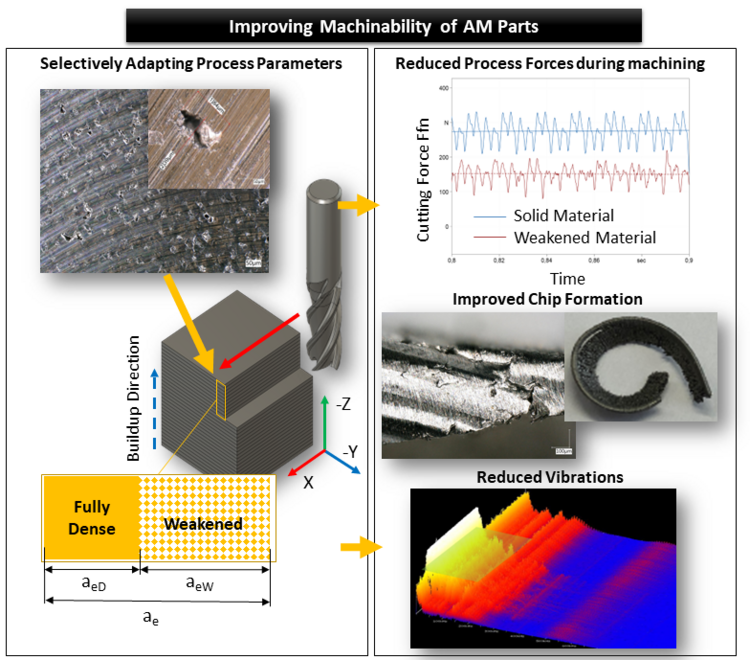Method for generating structures optimized for machining post-processing in powder bed-based metal 3D printing
Abstract
LPBF process for the generation of porous structures for the gentle machining of complex components with thin-walled and filigree structures
Advantages
- The new method makes it easier to rework surfaces in order to achieve high-quality surface finishes
- facilitates the removal of support structures
- makes it easier to produce delicate, fragile components that are often destroyed/damaged when applying conventional post-processing methods
- rotects cutting tools during reworking by reducing the process forces by up to 45%
Fields of application
Thin-walled and filigree components, such as topology-optimized components, which require post-machining. Possible areas of application are components from aerospace, automotive, tool making, machine tool making, but also medical technology. Examples are heat exchangers, bicycle forks, implants and others.
Background
For functional surfaces it is necessary to rework additively manufactured (AM) metal parts. This post-machining is currently based on decades of experience in the machining of conventional components. AM now offers new design options which help to influence the cutting process conditions locally and thus to improve the cutting conditions in a targeted manner. Powder bed-based (PBF) processes in particular offer a wide range of control options for this purpose.
Problem
Additive processes, especially powder bed-based 3D printing processes (such as Laser Powder Bed Fusion (LPBF) processes), are comparatively cost-intensive. The components to be manufactured with LPBF technology are therefore usually highly optimized and often feature thin-walled and bionic structures. Due to the surface qualities and fitting accuracies that cannot be sufficiently achieved with the LPBF process in some cases, e.g. in the production of functional surfaces such as sealing seats or guide surfaces, machining finishing steps are often necessary. In addition, support structures are often used in the LPBF process, which also have to be machined or removed in a stressing manner. Typically, the LPBF process attempts to produce a completely dense material in order to produce high quality components. However, dense and solid structures make it difficult to remove allowances and support structures during post-cut machining. Significant process forces can act on the complex, filigree or thin-walled component areas, which can ultimately damage or even destroy the structure or component. In addition, the forces also act on the tools used.
Solution
Scientists at the University of Stuttgart have developed a method to solve the problems described above and simplify the machining of AM components. According to the invention, the areas of the component to be machined are designed in the form of a porous structure. These porous areas have a reduced density compared to the areas that are not to be removed. The porous structure can thus be removed more easily with minimum machining forces. These porous structures are created by lowering the induced energy during the melting process. By selecting the appropriate parameters, the density and strength of various component areas can be specifically adjusted to produce solid or porous areas.
Initial analyses have shown that the weakened structure helps considerably reduce the machining forces during drilling and milling. As a result, the process forces that occur during milling have been reduced by up to 45%. During drilling, the improved chip shape led to high-quality surface finishes (Rz = 9.7 µm) and better cylindricity (< 0.09 mm). This helps with components that cannot withstand high machining forces and gives more freedom for the design and post-machining of optimized components. It is particularly advantageous for the demanding machining of advanced AM components.
Publication and links
C. Maucher et al., Journal of Production Engineering 2021, Improving machinability of additively manufactured components with selectively weakened material

